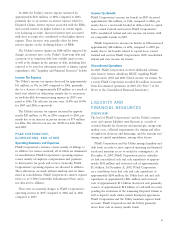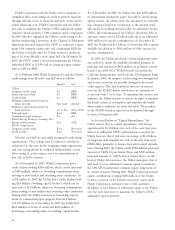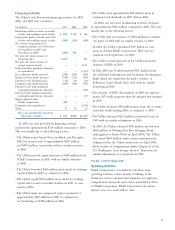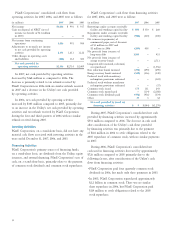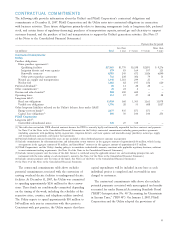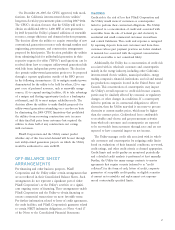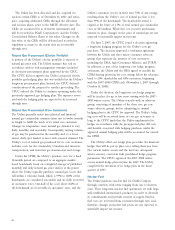PG&E 2007 Annual Report Download - page 59
Download and view the complete annual report
Please find page 59 of the 2007 PG&E annual report below. You can navigate through the pages in the report by either clicking on the pages listed below, or by using the keyword search tool below to find specific information within the annual report.57
On December 20, 2007, the CPUC approved, with modi-
fi cations, the California investor-owned electric utilities’
long-term electricity procurement plans covering 2007–2016.
The CPUC’s decision forecasts that the Utility will need to
obtain an additional 800 to 1,200 MW of new generation
by 2015 beyond the Utility’s planned additions of renewable
resources, energy effi ciency, and demand reduction programs.
The decision allows the utilities to acquire ownership of new
conventional generation resources only through turnkey and
engineering, procurement, and construction arrangements
proposed by third parties. The decision prohibits the utilities
from submitting bids for utility-build generation in their
respective requests for offers (“RFOs”) until questions can be
resolved about how to compare utility-owned generation bids
with bids from independent power producers. The decision
also permits utility-owned generation projects to be proposed
through a separate application outside of the RFO process
in the following circumstances: (1) to mitigate market power
demonstrated by the utility to be held by others, (2) to sup-
port a use of preferred resources, such as renewable energy
sources, (3) to expand existing facilities, (4) to take advantage
of a unique and fl eeting opportunity (such as a bankruptcy
settlement), and (5) to meet unique reliability needs. The
decision allows the utilities to make fl exible proposals for
utility-owned generation ratemaking on a case-by-case basis
by eliminating the 2004 CPUC limitations that prohibited
the utilities from recovering construction costs in excess
of their fi nal bid price from customers but required the
utilities to share half of any construction cost savings
with customers.
PG&E Corporation and the Utility cannot predict
whether any of this forecasted demand will be met through
new utility-owned generation projects on which the Utility
would be authorized to earn an ROE.
OFF-BALANCE SHEET
ARRANGEMENTS
For fi nancing and other business purposes, PG&E
Corporation and the Utility utilize certain arrangements that
are not refl ected in their Consolidated Balance Sheets. Such
arrangements do not represent a signifi cant part of either
PG&E Corporation’s or the Utility’s activities or a signifi -
cant ongoing source of fi nancing. These arrangements enable
PG&E Corporation and the Utility to obtain fi nancing or
execute commercial transactions on more favorable terms.
For further information related to letter of credit agreements,
the credit facilities, and PG&E Corporation’s guarantee related
to certain NEGT indemnity obligations, see Notes 4 and 17
of the Notes to the Consolidated Financial Statements.
Credit Risk
Credit risk is the risk of loss that PG&E Corporation and
the Utility would incur if customers or counterparties
failed to perform their contractual obligations. The Utility
is exposed to a concentration of credit risk associated with
receivables from the sale of natural gas and electricity to
residential and small commercial customers in northern
and central California. This credit risk exposure is mitigated
by requiring deposits from new customers and from those
customers whose past payment practices are below standard.
A material loss associated with the regional concentration
of retail receivables is not considered likely.
Additionally, the Utility has a concentration of credit risk
associated with its wholesale customers and counterparties
mainly in the energy industry, including other California
investor-owned electric utilities, municipal utilities, energy
trading companies, fi nancial institutions, and oil and natural
gas production companies located in the United States and
Canada. This concentration of counterparties may impact
the Utility’s overall exposure to credit risk because counter-
parties may be similarly affected by economic or regulatory
changes, or other changes in conditions. If a counterparty
failed to perform on its contractual obligation to deliver
electricity, then the Utility may fi nd it necessary to procure
electricity at current market prices, which may be higher
than the contract prices. Credit-related losses attributable
to receivables and electric and gas procurement activities
from wholesale customers and counterparties are expected
to be recoverable from customers through rates and are not
expected to have a material impact on net income.
The Utility manages credit risk associated with its whole-
sale customers and counterparties by assigning credit limits
based on evaluations of their fi nancial conditions, net worth,
credit ratings, and other credit criteria as deemed appropriate.
Credit limits and credit quality are monitored periodically
and a detailed credit analysis is performed at least annually.
Further, the Utility ties many energy contracts to master
agreements that require security (referred to as “credit
collateral”) in the form of cash, letters of credit, corporate
guarantees of acceptable credit quality, or eligible securities
if current net receivables and replacement cost exposure
exceed contractually specifi ed limits.


